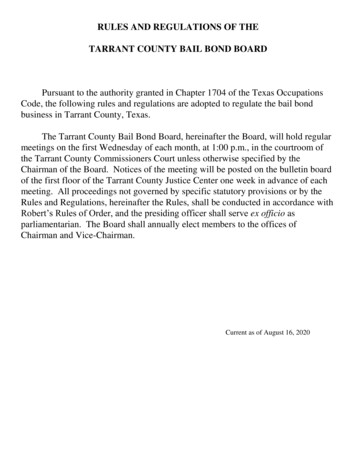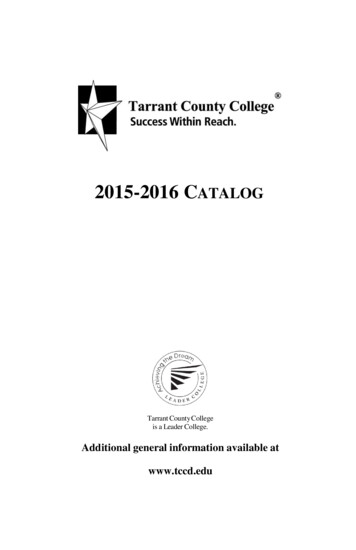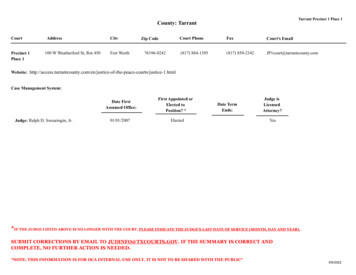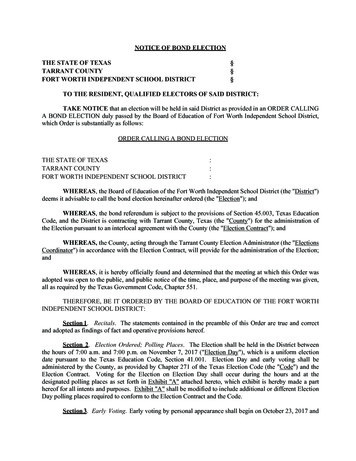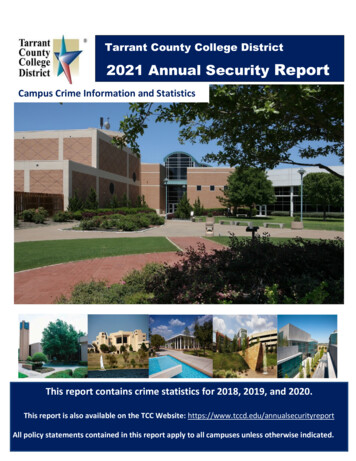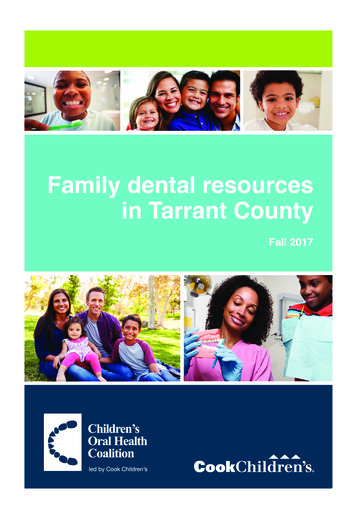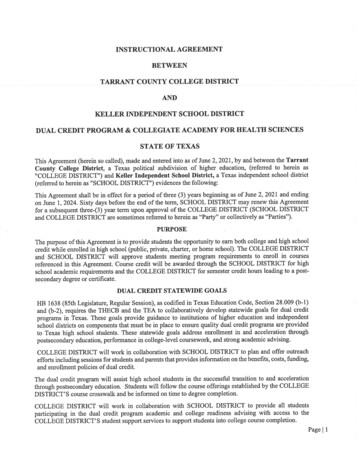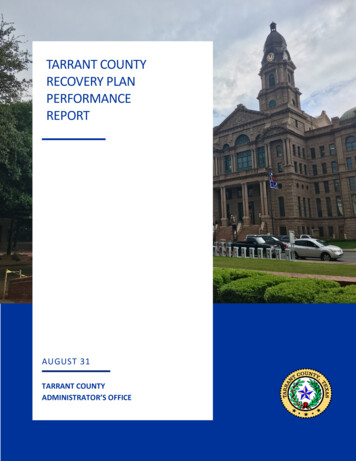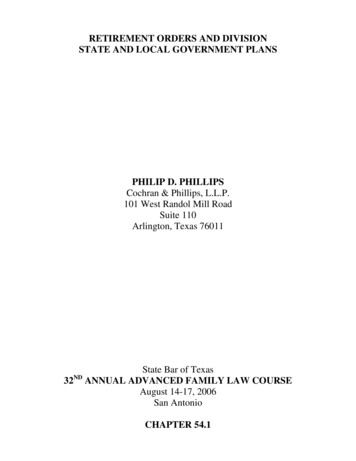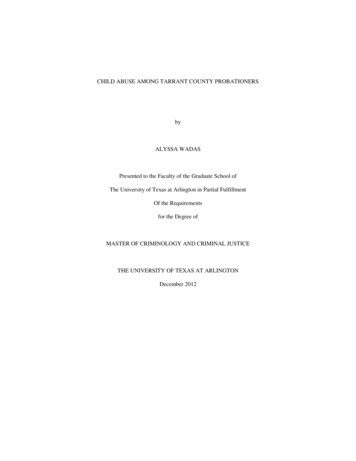
Transcription
CHILD ABUSE AMONG TARRANT COUNTY PROBATIONERSbyALYSSA WADASPresented to the Faculty of the Graduate School ofThe University of Texas at Arlington in Partial FulfillmentOf the Requirementsfor the Degree ofMASTER OF CRIMINOLOGY AND CRIMINAL JUSTICETHE UNIVERSITY OF TEXAS AT ARLINGTONDecember 2012
Copyright by Alyssa Wadas 2012All Rights Reservedii
AcknowledgementsI would like to acknowledge those who have given me a great amount of their time, help andknowledge. First, I would like to thank my major professor, Dr. Jaya Davis. You have been awonderful mentor and I will forever appreciate the knowledge, help and guidance you have given methrough this process. Additionally, I would like to thank Dr. Rodriguez and Dr. Butler for being greatresources through every step of my thesis and masters. I have gained an incredible amount ofknowledge from all of my professors.Finally, I would like to thank my family and friends who have stood by me through all thelong nights and hard work. I have been blessed with the most amazing family and friends, my parentsRobert and Jennifer, Brandon, Annika, Megan, Meagan, Brian, Michelle, Stephanie, Larry and Jeff.You have encouraged me, through all the good times and the bad, to keep moving forward. I amgrateful beyond words for your love and support, your patience, the debates, discussions, instruction,help, advice and most importantly, the laughs, along the way.November 26, 2012iii
AbstractCHILD ABUSE AMONG TARRANT COUNTY PROBATIONERSAlyssa Wadas, MAThe University of Texas at Arlington, 2012Supervising Professor: Jaya DavisChild abuse occurs throughout every city, in every state, in the United States. Child abuseoccurs in many different forms, including but not limited to: physical abuse, emotional abuse, sexualabuse, medical neglect, psychological abuse and neglect. For many children child abuse never getsreported and children have a lifetime to cope with the effects of the abuse without consequence to theabuser.The current study explores probationers who report to the Tarrant County Probation office inTarrant County Texas who have been convicted of or received deferred adjudication for committingan offense against a child in the State of Texas and their respective childhoods.iv
Table of ContentsAcknowledgements . . iiiAbstract . . ivList of Tables . .viiChapter1 Introduction .12 Literature Review . .42.1 History of Child Abuse Statutes in the United States . .42.2 Race, Poverty, Gender and Child Abuse . .72.3 Effects on Childhood Development Because of Abuse . .102.4 Child Abuse and Death . .112.5 Child Abuse and Juvenile Delinquency .122.6 Alcohol and Child Abuse. . 142.7 Domestic Violence and Child Abuse . 142.8 Recurrence of Child Abuse . .152.9 Offender .162.10 Offenders Abused as Children .172.11 Research Hypothesis . 183. Research methodology . .203.1 Institutional Review Board . .203.2 Survey Instrument . .203.3 Sampling and Sample Size .213.4 Dependent and Independent Variables .223.5 Timeline . .223.6. Design Analysis . 22v
4. Analysis . .234.1 Demographics . . 234.2 Probationers Criminal History .244.3 Probationers Respective Childhood and Overall Correlations . .255. Conclusions . 315.1 Results and Implications . 315.2 Study Limitations . .355.3 Future Studies . . 365.4 Conclusions . 37AppendixA. Definitions . .38B. Survey Instrument .43References . . .53Biographical Information .60vi
List of TablesTable4.1 Gender and Racial/Ethnic Background . .234.2 Offense of Conviction or Deferred Adjudication . .244.3 Identified Victims . .254.4 Frequency and Percent of Respondents who were Abused .264.5 Offense Committed by Respondent and Physical Abuse .274.6 Offense Committed by Respondent and Sexual Abuse . 284.7 Age of First Abuse . 294.8 Correlations of Childhood Abuse and Offense of Conviction/Deferred Adjudication . .30vii
Chapter 1IntroductionAccording to The National Child Abuse and Neglect Data System (NCANDS),approximately 903,000 children were victims of abuse and neglect during 2001. Based on a victimrate of 12.1 per 1,000 children, an estimated 899,000 children were found to be victims in the 50states, the District of Columbia, and Puerto Rico for 2005. For Federal Fiscal Year (FFY) 2009, anationally estimated 763,000 duplicate and 702,000 unique number of children were victims ofmaltreatment, including the death of more than 1,500 children (Paxson & Haskins 2009).There are many different ways a person can commit child abuse. Examples of child abuseinclude: physical abuse, emotional abuse, sexual abuse, medical neglect, psychological abuse, andneglect. Friedman (1990), notes that most states define child sexual abuse as nonconsensual physicalcontact with a minor for the purpose of sexual gratification. More specific, in the State of Texas, thedefinition of sexual assault of a child is: Sexual Assault as defined by the Texas Penal Code section22.011 (2) intentionally or knowingly: (A) causes the penetration of the anus or sexual organ of achild by any means; (B) causes the penetration of the mouth of a child by the sexual organ of theactor; (C) causes the sexual organ of a child to contact or penetrate the mouth, anus, or sexual organof another person, including the actor; (D) causes the anus of a child to contact the mouth, anus, orsexual organ of another person, including the actor; or (E) causes the mouth of a child to contact theanus or sexual organ of another person, including the actor. In (c) section: (1) "Child" means a personyounger than 17 years of age.Sexual assault of a child can affect who that child becomes and how they will act towardsothers. In a study of 72 children who engaged in sexual misconduct with other children, Gray,Busconi, Houchens, &Pithers (1997) determined that 95% of the children for whom maltreatment datacould be collected had been sexually abused. In addition, 48% had suffered physical abuse. Childrenare constantly going through a growing and developmental process which is affected by how they are1
raised and their individual life experiences. Sexual assault of a child can affect the child’sdevelopmental process in a negative way.Paxson and Haskins (2009) state that, a Federal Centers for Disease Control and Prevention(CDC) report issued in January 2008 offers five categories and definitions of maltreatment. Physicalabuse is "the intentional use of physical force against a child that results in, or has the potential toresult in, physical injury." Whereas, injury to a child defined by the Texas Penal Code section22.04, is, (a) A person commits an offense if he intentionally, knowingly, recklessly, or with criminalnegligence, by act or intentionally, knowingly, or recklessly by omission, causes to a child, elderlyindividual, or disabled individual: (1) serious bodily injury; (2) serious mental deficiency, impairment,or injury; or (3) bodily injury. (c) In this section: (1) "Child" means a person 14 years of age oryounger. Physical abuse is the second most common form of abuse, only second to neglect. Althoughit is the second most common form of abuse, from 1995 to 2005, there was a drop in the rate of abuse,as reported by Wulczyn (2009). Furthermore, Wulczyn (2009) found rates of physical abuse, thesecond most common type of maltreatment, dropped from 3.6 per thousand in 1995 to 2.1 perthousand in 2005.The U.S. Department of Health and Human Services reports that; in 2008, U.S. state andlocal child protective services (CPS) received 3.3 million reports of children being abused orneglected. Additionally, CPS estimated that 772,000 (10.3 per 1,000) of children were victims ofmaltreatment. Seventy-one percent of the children were classified as victims of child neglect; 16percent as victims of physical abuse; 9 percent as victims of sexual abuse; and 7 percent as victims ofemotional abuse. Additionally, in 2008, an estimated 1,740 children ages 0 to 17 died from abuse andneglect (U.S. Department of Health and Human Services). Based on the unique number of victims,702,000, reported by NCANDS as abused in 2009, an estimated 78 percent suffered neglect, anestimated 18 percent were physically abused, an estimated 10 percent were sexually abused, anestimated 8 percent were emotionally or psychologically maltreated, and an estimated 2 percent were2
medically neglected. These numbers indicate the extent of the problem of child abuse and the manydifferent forms of child abuse exhibited in the United States today.Although there are several different forms of child abuse, this paper focuses on physicaland sexual abuse as it relates to the definitions in the Texas Penal Code. These offenses include Injuryto a Child, Indecency with a Child, Sexual Assault of a Child, Aggravated Sexual Assault of a Child,and Aggravated Assault and Solicitation of a minor. (For full definitions of each offense refer toAppendix A). As part of the general discussion, prevalence, and relevance of child abuse, the historyof child abuse statutes and the effects on a child’s growth and developmental stages as they relate toabuse will be explored. Furthermore, research regarding the relationship between child abuse andjuvenile delinquency, race, poverty, gender and age, domestic violence, and alcohol abuse will bepresented. The purpose of this research is to examine the relationship between offenders who havebeen convicted of, or received deferred adjudication, for committing crimes against children and theirchildhood abuse experiences. Although research has been looked at the relationship between criminaloffenders and child abuse, generally, the current research fills a gap left in the literature byspecifically exploring types of offenses and types of abuse.3
Chapter 2Literature ReviewThe researcher will explain the history of child abuse in the United States. The researcherwill then break down recent statistics on child abuse as it relates to race, poverty and gender.Furthermore, the researcher will look at how childhood development is effected by abuse. Also, theresearcher will look at child abuse and how it relates to juvenile delinquency, alcohol use anddomestic violence. Finally, the researcher will look at the reoccurrence of child abuse and thoseoffenders who were abused as children.2.1 History of Child Abuse Statute in the United StatesAlthough children have been punished in the United States from the beginning of thecountry’s origin, child abuse as opposed to discipline, was not recognized as a problem until the late1800’s. Society’s first look at child abuse was decades before child abuse, as a medical definition, wasrevisited in the mid-1900s. The historical narrative of child abuse has two fundamental moments--thefirst, in 1872, was the fabled case of Mary Ellen Wilson who is said to have inspired the founding ofthe first Society for the Prevention of Cruelty to Children (SPCC); the second, in 1962, when Dr. C.Henry Kempe wrote a landmark article defining the "battered child syndrome," publicly exposingwhat doctors had long discussed in whispers, and inspiring America to rediscover child abuse after along period of dormancy (Shull, 1999).In 1874, the case of Mary Ellen Wilson inspired a crusade for the protection of children.Mary Ellen was a nine-year-old orphan who lived with the Connolly family, who frequently beat andberated her (Hollenbeck, 2001). Although there was no organization that helped battered children,Mary Ellen Wilson was eventually removed from the home and Mrs. Connelly was charged withassault and battery. Public outrage over Mary Ellen's case prompted the organization of the New YorkSociety for the Prevention of Cruelty to Children in 1874. In 1875, the State of New York enactedlegislation "that authorized cruelty societies to file complaints for the violation of any laws affectingchildren and required law enforcement and court officials to aid agents of the societies in the4
enforcement of these laws," thus creating the first statutory child protective services system in theUnited States (Hollenbeck, 2001). Although child protective services did not help to stop childrenfrom enduring the original abuse a child may endure, the services were created to remove childrenfrom homes and place them in safe environments to prevent further abuse.While there were several efforts made over the next few decades to help battered children, itwas not until the mid 1960s that the medical field began to truly recognize child abuse. In 1961, Dr.C. Henry Kempe described the "battered child syndrome" a clinical condition in young childrenwho have received serious physical abuse, generally from a parent or foster parent (Hollenbeck,2001). Evidence of battered child syndrome is used to make the logical inference that only someonewho is regularly caring for the child would have occasion to inflict these types of injuries, as anisolated act by a stranger would not result in a pattern of successive injuries over an extended periodof time (Estelle v McGuire 112 S. Ct 475 1991). Doctors began to use “battered child syndrome” todiagnose children who had the mark of abuse acquired over time. This was one of the first steps takenby doctors to diagnose children who have been abused.It took nearly another decade, before most states, and the federal government createdstatutes, to help abused children. Hollenbeck (2001) stated, in 1974, the federal government served asa catalyst in the further development of child protection systems, including child abuse registries, bypassing the Child Abuse Prevention and Treatment Act (CAPTA). CAPTA provides funding to statesthat comply with its specifications regarding services to abused and neglected children. To be incompliance, states must provide a statewide program to report abuse, investigate abuse and providefor a safe environment for the abused to be placed. Trost (1998) reported that, all fifty states, theDistrict of Columbia, American Samoa, Guam, Puerto Rico, and the U.S. Virgin Islands havereporting laws. Although state laws differ somewhat from other states laws, substantial uniformity informat and in overall effect now exists due at least in part to CAPTA's passage.There are many reasons why children of abuse fail to report abuse. A few of these reasonsinclude: children are too young to report abuse, children are too scared to report abuse, or children5
believe the abuse is a normal part of everyday life. Therefore, CAPTA provided for mandatoryreporting laws to help save children’s lives by getting them out of the abusive situation and into ahealthy, safe environment. Although the mandatory reporters can vary state to state, some of the mainreporters are: medical examiners, law enforcement officers, child care providers, mental healthprofessionals, teachers and social workers.Despite the creation of mandatory reporting laws, professionals who come into contact withchildren are often reluctant to report suspected child abuse (Dombrowski, Ahia, & McQuillan, 2003;Kenny, 2001; Reiniger, Robison, & McHugh, 1995; Shoop & Firestone, 1988). There are manyreasons for this reluctance, including misunderstanding of the reporting laws, fear of making aninaccurate report, a poor impression of child protective services, fear that reporting will exacerbate analready tenuous situation, fear of legal retribution or retaliation, belief that "proof" is needed before areport should be made, and lack of understanding of what contributes to maltreatment (Hinson &Fossey, 2000; Levin, 1983; Shor, 1997).In 1996, CAPTA was amended. One of the main changes to the CAPTA amendment is the“Good Faith” Immunity addition. requiring that in order to receive funding from the federalgovernment, states must have some form of immunity for mandatory reports of child abuse. Trost(1998) stated that although federal statute does not require a certain degree of immunity, the majorityof states have implemented provisions for “good faith” reporting. Additionally, a few states grantmandatory reporters with absolute immunity. Trost (1998) found that regardless of how the courtshave interpreted good faith, they have generally found defendants’ behavior to be within the necessarymandatory reporting parameters. However, the assumption underlying the “good faith” language inCAPTA is that too much reporting is occurring. The new language in CAPTA is likely to persuadestate courts that they have been providing too much immunity for doctors and other reporters.For pediatricians and emergency room physicians in particular, the responsibility toreport is already an expensive burden. Currently, most physicians who report knowthat they have statutory immunity for reporting, but they also know that suchimmunity does not preclude lawsuits which they must defend. Defending these suitsis time-consuming, disruptive, and emotionally draining. Furthermore, if physicians6
and hospitals face increased doubt that courts would dispose of such suits onsummary judgment, they will be much more likely to limit their reporting to injuriesthey know are abuse-related, rather than reporting mere suspicions (Trost, 1998).Removing the presumption of good faith would shift the burden of proof to defendants, essentiallyforcing them to go to trial on the issue of good faith; therefore, the policy shift may discourage courtsfrom continuing to recognize negligent reporting as falling under the purview of "good faith"(Trost,1998). The changes in the “good faith” exceptions in the statute would then allow for less falsereporting of child abuse.The second change in the amendment is the new emphasis on assessment. Trost (1998)states, the CAPTA amendments' new emphasis on "assessment" reflected criticism that mandatedreporters and social workers are inadequately trained to recognize child abuse, and that CPS agencieswere required to investigate every report they receive. In theory, if the numbers of erroneous reportsare reduced through training to increase social workers' ability to distinguish between "false" and"true" reports, then the available financial resources will better help the children and families whoreally need it (Trost 1998). With an emphasis on assessment, it was anticipated that there would befewer false reports and therefore, more time to focus on true cases of child abuse. With bettereducation for the mandatory reports, it is possible they will become more confident in their abilities torecognize and report child abuse.Finally, the last two changes described by Trost (1998) included changes in terminology,where “child and family protection" replaces the term “child protection". Additionally, the term"family" is inserted after the term “child" everywhere that “child" is listed and while enhancing theinterests of "families," that is parents, the Amendment also provide for "expedited termination" ofparental rights-but only in extreme and rare circumstances. Most recently, the Child Abuse Preventionand Treatment Act was re-authorized in 2010.2.2 Race, Poverty and Gender and Child AbuseRates of child abuse vary with the children’s’ racial/ethnic background. The National ChildAbuse and Neglect Data System (NCANDS) in 2008 reported African-American children, American7
Indian or Alaska Native children, and children of multiple races had the highest rates of victimizationat 16.6, 13.9, and 13.8 per 1,000 children of the same race or ethnicity, respectively. Hispanic childrenand white children had rates of 9.8 and 8.6 per 1,000 children of the same race or ethnicity,respectively. Asian children had the lowest rate of 2.4 per 1,000 children of the same race or ethnicity.Nearly one-half of all child abuse victims were White (45.1%), one-fifth (21.9%) were AfricanAmerican, and one-fifth (20.8%) were Hispanic.Overall, the rate of maltreatment among black children in 2006 (19.8 per thousand) wasnearly twice the rate for white children (10.7 per thousand), which is equivalent to a disparity rate of1.85 (19.8 divided by 10.7). At the state level, maltreatment rates in 2006 were higher for blacks thanfor whites in all but two states (Wulczyn, 2009). Further, Black children are 51 percent more likely tobe removed from their home due to child maltreatment than are white children (Freisthler, Bruce, &Needell, 2007 from the U.S. Department of Health and Human Services [HHS], 2004).Death from child abuse occurs across racial/ethnic boundaries but follows similardisproportionalities as rates of abuse generally. In 2008, it was reported that 39 percent of deaths werereportedly non-Hispanic white children, whereas, 30 percent of deaths were African-Americanchildren and 16 percent of deaths were Hispanic children (U.S. Department of Health and HumanServices).Furthermore in black families, Schuck (2005) found, the cumulative effects model was morestrongly related to child abuse and neglect. The cumulative effects model looks at all the factors in achild’s life and how they accumulate over time to affect the outcome of poverty, neglect and abuse oftheir future children. Higher child maltreatment reporting rates for Black children were associatedwith more black female-headed families in poverty. Additionally, the victimization rate for Blackchildren is significantly higher than the victimization rate for White children, and the burdens ofpoverty and concentrated poverty are disproportionately experienced by Black families and Blackfemale-headed families (Schuck, 2005). In their study, Freisthler, Bruce, and Needell, (2007) foundthat, the neighborhood impoverishment variables of female-headed families, poverty, and8
unemployment was positively related to rates of maltreatment among Hispanic children. For Whitechildren, the structural factors related to poverty; child care burden (percentage of elderly residentsand ratio of children to adults) and racial and ethnic composition (percentage of Hispanics); werepositively associated with neighborhood rates of abuse and neglect.Poverty occurs in many parts of the United States and has been a problem for many years.According to McCurdy and Daro (1994), in an annual survey, state child welfare officials reportedthat the recent loss of jobs was the most causative element in the increase in child abuse reports acrossthe country in 1992. Furthermore, Hay and Jones (1994) state, poverty can directly increase thechance for neglect due to lack of money for food and shelter. Poverty may have indirect effects thatincrease the likelihood of other problems that are considered to be related to maltreatment, or that atleast predict poor parenting outcomes. These indirect effects include increased parental stress, socialisolation and residence in communities with limited resources.National Child Abuse and Neglect Data System (NCANDS) in 2008 reported, victimizationwas split almost evenly between the sexes; 48.3 percent of victims were boys and 51.3 percent of thevictims were girls. Additionally, NCANDS found, the rate of child victimization for boys in the agegroup of birth to one year was 21.8 per 1,000 male children of the same age group. The childvictimization rate for girls in the age group of birth to 1 year was 21.3 per 1,000 female children ofthe same age group. The victimization rate for children in the age group of 4–7 years was 10.9 per1,000 for both boys and girls. However, Finkelhor, Hotaling, Lewis, and Smith (1990) conducted anational survey of 2,626 adults of at least 18 years of age and found 27 percent of the women and 16percent of the men reported at least one childhood sexual abuse experience. Abuse by strangers wasmore prevalent in boys (40%) than girls (21%), and abuse by family members was more likely withgirls (29%) than boys (11%). Therefore, females had a higher rate of being sexually abused by aknown offender and boys had a higher rate of being abused by a stranger. However, girls had a higheroverall rate of being sexually abused than boys.9
2.3 Effects on childhood development because of abuseA child transitions through many developmental stages from birth to adulthood. A childstarts out in life unable to even hold their head up, let alone crawl, walk, talk or understand conceptsin life. A child must be taught how to perform these basic life tasks by the people closest to them inearly life. Competence in working through these stages effect the way a child will grow, learn, anddevelop into a functional adult. At each developmental stage, parents' abilities to attend to their childand to guide and support their child’s negotiation of new developmental tasks are essential. Whenparents physically, emotionally, or sexually abuse their children, the parents' salience as a source ofprotection and support certainly is diminished (Margolin, & Gordis, 2000).Therefore, Margolin andGordis (2000) report, violence initially may result in primary effects, such as anxiety, depression, orPTSD symptoms, which cause secondary reactions by disrupting children's progression through ageappropriate developmental tasks. For example, exposure to violence in young children can result inregressive symptoms, such as increased bedwetting, decreased verbalization, or separation anxiety(Osofsky, 1995). Furthermore, Wulczyn (2009) states, in early childhood, maltreatment can impairbrain development and regulatory functioning; later in childhood, maltreatment-related problems suchas poor school performance, increased disruptive behaviors, and depression emerge; oncemaltreatment victims reach adulthood, they are more likely to abuse substances. If a child is not raisedin a good environment, rich with learning proper behaviors and ways about life, then it is possible thewill have a hard time learning to be a functional adult. Finally, Gratz, Paulson, Jakupcak, and Tull(2009) report that theoretical literature suggests that the experience of maltreatment during childhoodinterferes with the development of adaptive emotion regulation, exposing children to extremeemotional demands while simultaneously failing to teach them how to regulate emotional arousal,control their behaviors in the context of emotional arousal, and/or tolerate emotional distress. Childrenwho only see violence in life, and violence as a solution to every problem with the adults in their life;will quite possibly believe violence is the only solution to their problems.10
Although abuse can occur at all ages, there are certain ages when children are more likely toexperience abuse. In 2008 the National Child Abuse and Neglect Data System (NCANDS) reportedthat, nearly one-third (32.6%) of all victims of maltreatment were younger than 4 years of age. Anadditional 23.6 percent were in the age group 4–7 years and 18.9 percent were in the age group 8–11years. In accordance with NCANDS data, Wulczyn (2009) found, the rate of maltreatment by ageshows that infants, with an overall maltreatment rate of twenty-four per thousand, still face thegreatest risk. They are 1.8 times more likely to be maltreated than one to three-year-olds, the groupwith the next highest maltreatment rate. Infant victimization rates exceed twenty per thousand in thirtystates. The rate of maltreatment is highest for infants in all but two states. In short, few trends inmaltreatment are as stable and clear as the link between age and maltreatment risk (Wulczyn 2009).There are many possible reasons that infants have a higher rate for being abused. Friedrichand Boriskin (1976) implicated certain infant and early childhood characteristics as possiblecontributors to abuse. These include such factors as prematurity, low birth weight, difficult infanttemperament, and early mother-infant separation. It was hypothesized that these variables interferedwith the formation of secure mother-infant attachment, and/or augmented stress in the family, thusresulting in an increased prospect for abuse. Additionally, infants cannot defend themselves the sameas older children. For these reasons it is intuitive that the youngest children had the highest rate ofvictimization, and overall, the victimization rates decreased for older age groups (NCANDS 2008).2.4 Child Abuse and DeathEvery year there are hundreds of children who die from abuse and neglect. In 2008, the U.S.Department of Health and Human Services found, in 2008, an estimated 1,740 children ages 0 to 17died from abuse and neglect. This is compared to an estimated 1,760 children nationally, who diedfrom abuse or neglect in 2007 and 1,530 children who died from abuse or neglect in 2006.Additionally, the U.S. Department of Health and Human Services found that in 2007, more than 40percent (42.2%) of all fatalities were children younger than one year. Additionally, 16.5 percent werechildren age one year, 10.7 percent were children age two years and 6.3 percent were children age11
three years. Therefore, 75.7 percent were younger than four years old. Nearly 13 percent (12.9%)were between the ages of 4-7 years,
CHILD ABUSE AMONG TARRANT COUNTY PROBATIONERS Alyssa Wadas, MA The University of Texas at Arlington, 2012 Supervising Professor: Jaya Davis Child abuse occurs throughout every city, in every state, in the United States. Child abuse occurs in many different forms, including but not limited to: physical abuse, emotional abuse, sexual


